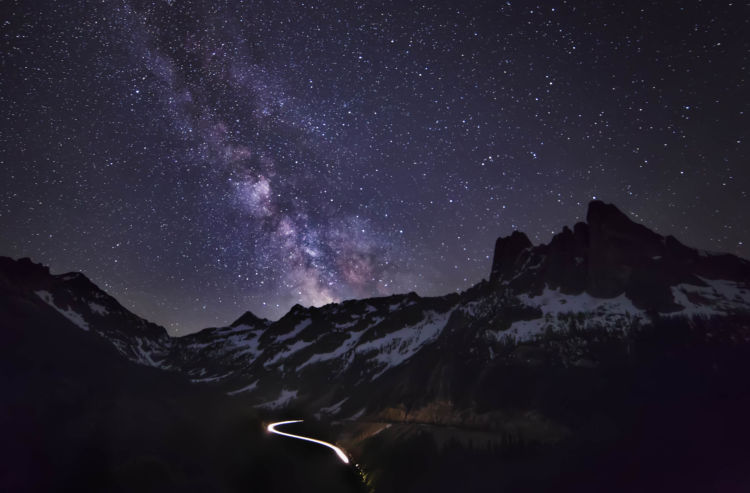Photographing the Night Sky
The difficult thing about photographing the night sky in the summer is staying up late enough for it to get dark. We’re lucky on the Gunflint Trail because it does get dark and we can see the Milky Way. Have you read the news that 80% of Americans can’t see the Milky Way because of light pollution? Just another reason to visit the Boundary Waters to photograph the night sky and the Milky Way.
May 27, 2016
Category: Recreation by Andy Porter
Andy Porter is a professional photographer based out of Seattle, Washington. Browse his photography online or sign-up for one of his several classes.
How dark does it have to be to capture a good photo of the nighttime sky, and what about other factors, like altitude, humidity or air pollution?
To capture clear images of stars and the Milky Way you need a very dark sky. Sunlight reflected by the moon is so bright that it obscures visibility of the stars. Time your efforts to match the New Moon (when the moon is not visible at all). Then visit a location away from the lights of cities and towns, such as our National Forests!
What type of camera equipment do you need for good nighttime pictures? Can a cellphone camera or point-and-shoot do the job?
Camera-wise you need a basic DSLR camera and a wide angle lens to get started. Cell phones and point-and-shoot cameras will not work because they don’t capture enough light. Ideally you would have a full-frame DSLR and a wide angle lens (10 – 16mm) along with a tripod and cable release.
For optimal composition, do you want anything in the foreground or just the night-sky itself?
Any images of the Milky Way are stunning. Just seeing the dense band of stars and the mottled colors of stellar gases glowing is enough to excite.
Adding elements in the foreground creates a layering effect and depth. Some of my favorites are tents and fire lookout towers; seeing them glow with light before the Milky Way is quite stunning.
It takes some experimentation to get the right amount of illumination inside them, for example with a tent image I have my friend in the tent turn on the flash light for one or two seconds while I have the shutter open for a full 30 seconds. I have seen incredible night sky shots using barns, roads, statues, waterfalls, trees and rock formations in the foreground. Be creative!
Do you ever use a flash?
I never have used a flash for the night sky images, though many photographers will use headlamps, flashlights or other light sources to “light paint” the foreground. This helps brighten an otherwise dark foreground so that its details will show up in your image.
How important is computer editing when taking photos of the night sky?
When you are out under the night sky in a dark place the strip of the Milky Way is clearly visible. But to make the arc of the Milky Way pop out the images will need some editing. When I edit I am working to make the stars brighter and add contrast to the sky. At the same time I often brighten the foreground somewhat, and lastly I use noise reduction software to reduce the graininess of the final image.
What are some of the biggest challenges when taking night-sky photographs?
The biggest challenge, by far, is simply to have a night when there is no moon and no clouds! Focus is also an issue. The auto-focus on a camera/lens will not work at night. You must set your lens to manual focus. Before you head out take time to set your lens on manual focus and experiment so that you know exactly where to set your focus ring for infinity. More often than not the infinity setting for focus is NOT where the infinity symbol is on the lens, so it’s very important to get this figured out first.
Do you have any special tips for photographing the Milky Way?
It takes some practice to get it right, so be patient. Get out nearby on a clear night and do a test run, work on getting your exposure and focus right.
Find a lunar calendar and mark the New Moon each month so you’ll know when to head out. If you are within 2 days, plus or minus of the New Moon, you’ll be fine. Next, make a list of possible locations see if you can make a visit during the day to scout for the best shooting locations. And lastly, find some like-minded friends and have a blast under the stars!
What are some of your favorite places on National Forests to shoot the night sky?
- Washington Pass Overlook (on Highway 20) in the Okanogan-Wenatchee National Forest
- Park Butte Lookout in the Mount Baker-Snoqualmie National Forest
- Artist Point and Picture Lake (on Highway 542) in the Mount Baker-Snoqualmie National Forest
- Winchester Lookout in the Mount Baker-Snoqualmie National Forest
Learn more about Andy Porter and his photography at AndyPorterImages.com.


Leave a Reply
You must be logged in to post a comment.